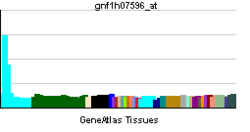G protein-coupled bile acid receptor
| View/Edit Human | View/Edit Mouse |
The G protein-coupled bile acid receptor 1 (GPBAR1) also known G-protein coupled receptor 19 (GPCR19), membrane-type receptor for bile acids (M-BAR) or TGR5 as is a protein that in humans is encoded by the GPBAR1 gene.[4]
Function
This gene encodes a member of the G protein-coupled receptor (GPCR) superfamily. This protein functions as a cell surface receptor for bile acids. Treatment of cells expressing this GPCR with bile acids induces the production of intracellular cAMP, activation of a MAP kinase signaling pathway, and internalization of the receptor. The receptor is implicated in the suppression of macrophage functions and regulation of energy homeostasis by bile acids.[5]
One effect of this receptor is to activate deiodinases which convert the prohormone thyroxine (T4) to the active hormone triiodothyronine (T3). T3 in turn activates the thyroid hormone receptor which increases metabolic rate.[6][7]
References
- ↑ "Drugs that physically interact with G-protein coupled bile acid receptor 1 view/edit references on wikidata".
- ↑ "Human PubMed Reference:".
- ↑ "Mouse PubMed Reference:".
- ↑ Kawamata Y, Fujii R, Hosoya M, Harada M, Yoshida H, Miwa M, Fukusumi S, Habata Y, Itoh T, Shintani Y, Hinuma S, Fujisawa Y, Fujino M (2003). "A G protein-coupled receptor responsive to bile acids". J. Biol. Chem. 278 (11): 9435–40. doi:10.1074/jbc.M209706200. PMID 12524422.
- ↑ "Entrez Gene: GPBAR1 G protein-coupled bile acid receptor 1".
- ↑ Watanabe M, Houten SM, Mataki C, Christoffolete MA, Kim BW, Sato H, Messaddeq N, Harney JW, Ezaki O, Kodama T, Schoonjans K, Bianco AC, Auwerx J (2006). "Bile acids induce energy expenditure by promoting intracellular thyroid hormone activation". Nature. 439 (7075): 484–9. doi:10.1038/nature04330. PMID 16400329.
- ↑ Baxter JD, Webb P (2006). "Metabolism: bile acids heat things up". Nature. 439 (7075): 402–3. doi:10.1038/439402a. PMID 16437098.
Further reading
- Takeda S, Kadowaki S, Haga T, et al. (2002). "Identification of G protein-coupled receptor genes from the human genome sequence.". FEBS Lett. 520 (1-3): 97–101. doi:10.1016/S0014-5793(02)02775-8. PMID 12044878.
- Maruyama T, Miyamoto Y, Nakamura T, et al. (2003). "Identification of membrane-type receptor for bile acids (M-BAR).". Biochem. Biophys. Res. Commun. 298 (5): 714–9. doi:10.1016/S0006-291X(02)02550-0. PMID 12419312.
- Strausberg RL, Feingold EA, Grouse LH, et al. (2003). "Generation and initial analysis of more than 15,000 full-length human and mouse cDNA sequences.". Proc. Natl. Acad. Sci. U.S.A. 99 (26): 16899–903. doi:10.1073/pnas.242603899. PMC 139241
 . PMID 12477932.
. PMID 12477932. - Kawamata Y, Fujii R, Hosoya M, et al. (2003). "A G protein-coupled receptor responsive to bile acids.". J. Biol. Chem. 278 (11): 9435–40. doi:10.1074/jbc.M209706200. PMID 12524422.
- Ota T, Suzuki Y, Nishikawa T, et al. (2004). "Complete sequencing and characterization of 21,243 full-length human cDNAs.". Nat. Genet. 36 (1): 40–5. doi:10.1038/ng1285. PMID 14702039.
- Gerhard DS, Wagner L, Feingold EA, et al. (2004). "The status, quality, and expansion of the NIH full-length cDNA project: the Mammalian Gene Collection (MGC).". Genome Res. 14 (10B): 2121–7. doi:10.1101/gr.2596504. PMC 528928
 . PMID 15489334.
. PMID 15489334. - Watanabe M, Houten SM, Mataki C, et al. (2006). "Bile acids induce energy expenditure by promoting intracellular thyroid hormone activation.". Nature. 439 (7075): 484–9. doi:10.1038/nature04330. PMID 16400329.
- Thomas SM, Bhola NE, Zhang Q, et al. (2007). "Cross-talk between G protein-coupled receptor and epidermal growth factor receptor signaling pathways contributes to growth and invasion of head and neck squamous cell carcinoma.". Cancer Res. 66 (24): 11831–9. doi:10.1158/0008-5472.CAN-06-2876. PMID 17178880.
- Yasuda H, Hirata S, Inoue K, et al. (2007). "Involvement of membrane-type bile acid receptor M-BAR/TGR5 in bile acid-induced activation of epidermal growth factor receptor and mitogen-activated protein kinases in gastric carcinoma cells.". Biochem. Biophys. Res. Commun. 354 (1): 154–9. doi:10.1016/j.bbrc.2006.12.168. PMID 17214962.
- Keitel V, Reinehr R, Gatsios P, et al. (2007). "The G-protein coupled bile salt receptor TGR5 is expressed in liver sinusoidal endothelial cells.". Hepatology. 45 (3): 695–704. doi:10.1002/hep.21458. PMID 17326144.
External links
- "Bile Acid Receptor". IUPHAR Database of Receptors and Ion Channels. International Union of Basic and Clinical Pharmacology.
- GPBAR1 protein, human at the US National Library of Medicine Medical Subject Headings (MeSH)
This article incorporates text from the United States National Library of Medicine, which is in the public domain.
